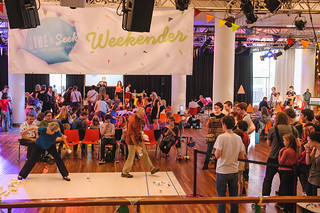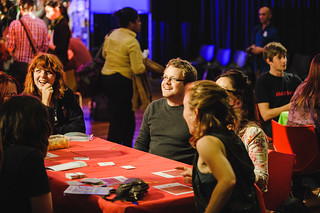Playing in Public: 5 Things Devs Need to Learn
- By Grant Howitt
- Updated: 8th Oct, 2012
 Hide and Seek, as well as being a popular children’s game (and an excellent way to get rid of younger nephews for up to half an hour, depending on how thick they are) is a London-based collective that runs, curates and funds creativity within the live-gaming arts. They’re pulling some next-level stuff, bringing artists and games developers and architects and musicians and technicians and all sorts of smart, creative people together and seeing what results, forging new ideas of what “play” can be. They’re pretty cool guys.
Hide and Seek, as well as being a popular children’s game (and an excellent way to get rid of younger nephews for up to half an hour, depending on how thick they are) is a London-based collective that runs, curates and funds creativity within the live-gaming arts. They’re pulling some next-level stuff, bringing artists and games developers and architects and musicians and technicians and all sorts of smart, creative people together and seeing what results, forging new ideas of what “play” can be. They’re pretty cool guys.
A few weeks ago, they kicked off the Hide and Seek weekender, a four-day festival of live-action games from new and established developers, down at the South Bank Centre in London. I even played one of them, and then went to a party where crotch-mounted Atari joysticks were used as fencing weapons. It all got a bit weird.
In addition to insurrection and crotch-jousting, though, they also hold a conference throughout the following Monday where the best and brightest minds in the games industry come together to talk about what the future of play could look like – or, more precisely, Playing in Public. Covering everything from pretending to be a killer bee to investment methods for active games to punching custard to the Olympics.
Hence, here are the five biggest lessons that developers – both Live and Computer, in many cases – should take away from the conference, distilling a whole day’s worth of sitting quietly in a room trying to look awake into something that you can read over your morning coffee for literally nothing.
Don’t make games to see if they’ll work – George Buckenham
Obvious, right? George Buckenham is a mainstay of the London indie-gaming scene, and his game Punch the Custard (in which you, well, punch some custard and some technology measures how many times you’ve punched it in 30 seconds) went down a storm at the Weekender. A lot of his games, including ghost-based shooter Hell is Other People and one where you had to wear a special vibrating helmet and shut your eyes whilst you play, are based off puns, experimentation, or a strange desire to see a daft idea through for far too long.
His one successful game (in his own words) – Squares, available on iPad – isn’t all that experimental at all. So if you’re trying to do something new, untested and wild, maybe see if the technology works first before you pin too much on making a proper game out of it. Pride, tenacity and curiosity don’t always result in worthwhile products.
Make the outcome matter – Bennett Foddy
Bennett Foddy, inventor of internet legend QWOP and more recent horse-based success CLOP, performed a five-minute presentation made up solely of weeping Olympians. Second places, near misses, and repeated, crushing failures were shown on the screen and he told the story behind each one, delighting in the incredible sadness etched on the faces of the distraught athletes.
He put forward the opinion that many Olympic sports are “dumb games with stupid designs,” and that as game designers we can – and do – create better mechanics, but we can’t yet trigger that level of utter, world-ending distress at missing the top space. Can games make people weep, and draw crowds of millions all over the world? Do the stories need to less outlandish, and closer to home, to connect with people? Maybe one day.
Do a Wizard of Oz test – Claire Redington
I run live games in my spare time, and I’ve stared down broken tech at 2 in the morning whilst crowds of angry players are hammering on the doors. I know all too well that, for all the great applications technology can provide, using it as a crutch for game experiences in live events is fraught with danger – just like in I, Robot, but with a broken strip light instead of a mechanical uprising.
 Claire Redington of the Bristol Watershed, a gathering space for arty, sciency and gamey types to mix together and create fascinating things, said how important it was to do a Wizard of Oz test. At some point in your game, the wiring might fail or the batteries might run out and you’ll find yourself encouraging players not to look behind the curtain lest the world crash down around their ankles. Don’t let that happen – make sure, as much as is possible, that the game can be experienced without too much technology being required for the experience.*
Claire Redington of the Bristol Watershed, a gathering space for arty, sciency and gamey types to mix together and create fascinating things, said how important it was to do a Wizard of Oz test. At some point in your game, the wiring might fail or the batteries might run out and you’ll find yourself encouraging players not to look behind the curtain lest the world crash down around their ankles. Don’t let that happen – make sure, as much as is possible, that the game can be experienced without too much technology being required for the experience.*
Focus on the unsettling – Kars Alrink
For new games to excel, they have to be strange. Kars Alrink, a man who’s designed games for pigs to play against humans (it improves their living conditions, apparently, and must therefore make them taste better as a result) championed this, saying that as things stand live games have been tamed and domesticated into a fine subset of genres. The biggest movements in the development industry aren’t going to come from people who play it safe, but those who deliberately push boundaries into weird places.
It’s hard to offer advice on this, obviously, as if anyone knew what the next big move was they’d be making it. But it’s coming from co-opting signals, of inverting the traditional power structures of cities and technologies to give power and expression to the user, not the creator.
Remove self-selection
 For the longest time, I didn’t play online games. I tried to, a couple of times, but I found myself vastly outperformed by my opponents and promptly became dissuaded – and that stuck, so even though I’d only proven I wasn’t very good at Command and Conquer Red Alert 2, for example, I’d rule out playing all RTS titles online because of the same stigma.
For the longest time, I didn’t play online games. I tried to, a couple of times, but I found myself vastly outperformed by my opponents and promptly became dissuaded – and that stuck, so even though I’d only proven I wasn’t very good at Command and Conquer Red Alert 2, for example, I’d rule out playing all RTS titles online because of the same stigma.
I’m over it now. I still suck, but I’m better at dealing with it.
Jamie Woo, creator of Gargoyles – a cross between Operation and Twister that you play in teams, aiming to outmanoeuvre your opponents – wants to break this down. The above example is fairly common in gamers, but there are parts of society who will instinctively remove themselves from participation thanks to a perceived lack of ability. Making games democratic, and removing the mastery element from them, makes the playing field invitingly equal.
Hide and Seek run live gaming events throughout the year.
* Obviously, this tip is only for live games. If you remove the technology from a computer game you have Staring At A Wall, which is cheap to produce but not focused toward player engagement. Still, though – depending on fancy new advances as a computer game dev, rather than strong mechanics and interesting narrative, could be just as much as a problem.
About Grant Howitt
Grant Howitt is a freelance games journalist who regularly writes for publications like The Guardian, PSM3, and FHM. He's been gaming since his mum got him a second-hand Mega Drive when he was seven, and he hasn't looked back since. Favourite games include Max Payne 2, Ocarina of Time, GTA San Andreas and Shadow of the Colossus - anything third-person with plenty of style. When not playing video games he's playing tabletop RPGs (or writing them himself) and running Zombie LARP, which is a LARP, with Zombies in. Grant is incredibly available for commissions at this time and will generally work for a cup of tea and the bus fare home.

One Comment